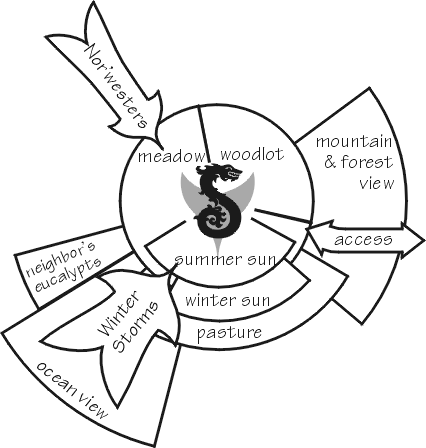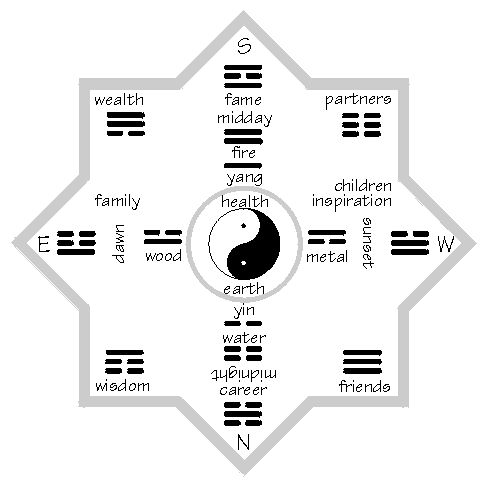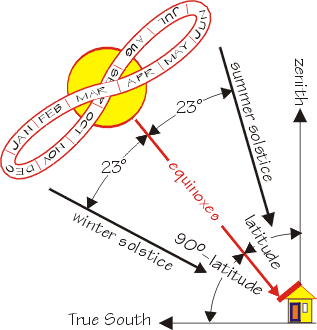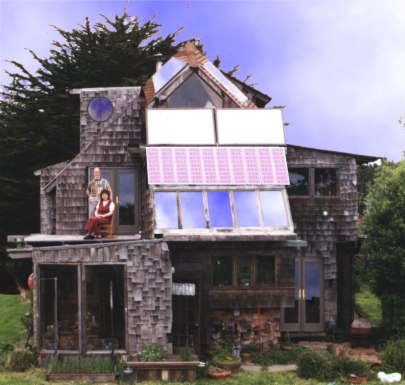
 |
The New Independent Home
by Michael Potts

from Chapter 6:
The Site Rose |

Caspar site rose
Once a potential site is found, its uniqueness, which architects call the genius loci or "genius of the place," must be mapped and described before a satisfactory house can be built. Although this information may take years to gather, it is important to make a preliminary estimate before a commitment is made to purchase the property, so the buyers can be sure that they will be able to build a suitable home.
Geographic and seasonal factors are critical considerations in choosing a site and situating a home. The sweep of winter storms, the direction and frequency of spring and autumn gales, the source of the prevailing breeze that tempers summer's heat, can all be ignored in favor of other preferences, but at considerable cost, because an ill-sited (or ill-suited) dwelling is at the mercy of the earth's forces.
Many modern houses are built on flat, agriculturally valuable land because this makes production-line building easier, and maximizes the developer's short-term profit. These homes, of course, are horrors. Few independent homes are on flat land; their owners explain that they looked to the little hills, not to the cornfields, for their home sites. In the hills, favorable dispositions of sun, slope, wind, and water make for a home that is more interesting to live in. Because homes serve their residents, not their builders, commodity housing seldom suits householders well. Could this be one reason that the average tenancy in a subdivision house is less than four years? |

| Asian builders observe the ancient practices of feng shui (wind and water) in the proper siting and interior design of their homes. This ba-gua can be applied to any home by orienting it with the entryway at the bottom, although agreement with the compass directions is considered by geomancers to be preferable. Note that the directions are rotated 180 degrees from our "normal" occidental convention. |
One difference between a house and a home is the harmony (or disharmony) of shelter and site. For centuries, oriental geomancers have studied the feng shui of building sites, the concordance between a shelter and the energy flowing in its surroundings. Westerners take similar readings, and call the results their site study.
A site rose is a graphical way of depicting the currents and flows that a site brings to bear on a house. (You did something very much like this in the last chapter when you drew your site map. As you glean new information, you should go back to review and update your site drawing as necessary.) A solar home's principal determinant is its relationship to the sun. Houses in any net-heating regime are usually best built with their longest dimension running east-to-west, their longest side facing the sun. In net-cooling climates, the shortest side should face the sun to limit unwanted solar gain. Conventional American homes slavishly align their longest dimension with the street, thereby enhancing what realtors call "curb appeal." (I am always reminded of the way cats turn sideways and fluff themselves up to look bigger to rivals.) Since streets usually reflect nothing more sensitive than a developer's whim or a cat-skinner's convenience, it will be only by accident or dint of great heart on the part of residents that dwellings like this ever become homes. (I hold that love can overcome almost everything, including bad feng shui.) The forces indicated by the site rose are inevitable. Atop my bluff in Caspar, December through March brings powerful storms from the southwest; all year long, dry, cold northwesterlies cleanse the air two days out of five. Here as everywhere in the northern temperate zones, the sun rises to the east, arcs high to the south at noon, then angles back to the west. These are the forces to which a house must respond if it is to become a home. |

| To get the most out of a building's roof, align it with the sun's best angle, which is determined by latitude and the season. An analemma -- the figure-eight shape -- represents the sun's motion during the year. On the equinoxes in Caspar, the best roof angle is 50.8° or, in roofer's terms, about 9.75 in 12. In Amherst, Wisconsin, the angle would be 47.8° (10.9 in 12); in Miami, Florida, 64.5 (5.75 in 12). The general formula for the roofer's measure is 12*tan(Latitude) in 12. |

|
The earth's wobble, or precession, is 23° which means the sun's direction changes 46° from north to south and back every year. For the optimal alignment at the equinoxes, the roof's angle from the horizontal is equal to 90° minus the latitude. Steepen the angle by as much as 15° to gather more solar energy in the winter. |

|
In Caspar, winter's defect is horizontal wind-driven rain and biting cold, and summer's is fog. Across the northern tier and in Alaska, winter is the problem, with wind, interminable biting cold, and its cohort sleet, ice, and snow; summer's only flaw is brevity. Even if you have never before given a thought to mapping your home's relationship to its ruling forces and features, you could sketch the most basic features of your place's site rose. Some influences exist everywhere, including the sun's light, but others are subtle and may take years and special attention to discern.

| The south face of a solar home collects energy in many ways. Windows in the author's home allow sunlight in -- the ocean view is a bonus -- while collectors on the roof harvest electrons and heat domestic hot water. On the deck, the author stands behind his partner Rochelle Elkan. |
|

|


